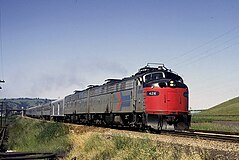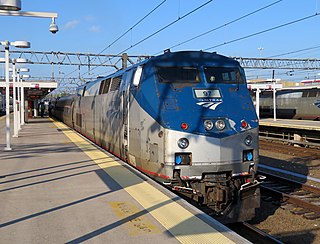Current
Locomotives
Amtrak operates diesel, electric, and dual-mode (diesel or electric) locomotives. Its electric locomotives are confined to the Northeast Corridor and the Philadelphia to Harrisburg Main Line, dual-mode locomotives are only used in the Empire Corridor between Albany and New York, and the diesel locomotives are used in all other areas across in the United States.
| Model | Thumbnail | Road numbers | Active fleet | Year | Power type | Owner |
|---|---|---|---|---|---|---|
| Road power | ||||||
| GE Dash 8-32BWH |  | 500–519 | 17 | 1991 | Diesel | Amtrak |
| GE Genesis P40DC |  | 800–843 | 11 | 1993 | ||
| GE Genesis P42DC | 1–207 | 154 | 1996–2001 | |||
| GE Genesis P32AC-DM | 700–717 | 18 | 1995 | Dual-mode | ||
| Siemens ACS-64 |  | 600–665, 667–670 | 67 | 2014 | Electric | |
| Siemens Charger ALC-42 |  | 300–424 | 49 (125) | 2021 | Diesel | |
| State-owned road power | ||||||
| GE Dash 8-32BWH |  | 2051, 2052 | 1 | 1991 | Diesel | Caltrans |
| EMD F59PH |  | 1810, 1859, 1869, 1893 | 4 | 1988 | NCDOT | |
| EMD F59PHI |  | 1755, 1797 | 2 | 1998 | ||
| 1871, 1984 | 2 | 1990 | ||||
| 2001–2009 | 8 | 1994 | Caltrans | |||
| 2010–2015 | 5 | 2001 | ||||
| Siemens Charger SC-44 |  | 1400–1401, 1403–1408 | 8 | 2016 | WSDOT | |
| 2101–2124 | 22 | Caltrans | ||||
| 4601–4633 | 30 | IDOT | ||||
| Non-Revenue/Switcher Locomotives | ||||||
| EMD SW1 |  | 737 | 1 | 1941 | Diesel | Amtrak |
| GE 80-ton switcher | 1100 | 0 | 1952 | |||
| EMD SW1000R |  | 794, 796 | 2 | 1952 | ||
| EMD MP15 | | 530–539 | 7 | 1970 | ||
| EMD SW1500 | 541 | 1 | 1970 | |||
| EMD SW1001 | 569 | 1 | 1974 | |||
| EMD GP38-3 |  | 720–724 | 5 | 1976 | ||
| 725–754 | 20 | 1960s/70s [lower-alpha 1] [lower-alpha 2] | ||||
| MPI GP15D |  | 570–579 | 10 | 2004 | ||
| MPI MP14B | | 590, 592, 593 | 3 | 2010–2013 | Diesel Genset | |
| MPI MP21B | 591 | 1 | 2010 | |||
| NRE 2GS12B |  | 597, 599, 792, 793, 798 | 5 | 2014–2020 | ||
| Sources: [1] [7] [8] [9] [10] | ||||||
Passenger cars
As of late 2018, Amtrak rostered 1,408 passenger cars of various types. These include coaches, lounges, dining cars, sleeping cars, baggage cars and crew/dormitory cars. [1] : 48–51
| Model | Thumbnail | Road Numbers | In service | Year built | Owner |
|---|---|---|---|---|---|
| Metroliner cab car |  | 9632–9651 | 15 | 1967–1970 [lower-alpha 3] | Amtrak |
| Amfleet I | 43346–48196, 81500–82999 | 454 | 1975 | ||
| Amfleet II | 25000–28024 | 141 | 1981 | ||
| Superliner I |  | 31000–38034 | 221 | 1979 | |
| Superliner II | 32070–39046 | 169 | 1993 | ||
| Horizon |  | 53501–58108 | 89 | 1988 | |
| Viewliner (prototype) |  | 2300–2301; 8400 | 1 | 1987 | |
| Viewliner I | 62000–62049 | 49 | 1995 | ||
| Viewliner II | 61000–69009 | 119 | 2015 | ||
| Surfliner |  | 6300–6908 | 37 | 2000 | |
| F40PH NPCU |  | 90200–90413 | 14 | 1977–1981 [lower-alpha 4] | |
| HHP-8C NPCU | 9750–9751 | 2 | 1999 [lower-alpha 5] | ||
| Autorack |  | 9200–9279 | 77 | 2005 | |
| State-owned cars | |||||
| California Car |  | 8001–8814 | 65 | 1996 | Caltrans |
| Surfliner |  | 6351–6965 | 22 | 2002 | |
| Comet IB |  | 5001–5014 | 14 | 1968 [lower-alpha 6] | |
| North Carolina Fleet |  | 400001–400205 | 20 | 1952–1965 | NCDOT |
| F40PH NPCU |  | 90252–90253, 90340 | 3 | 1977, 1980 [lower-alpha 7] | ODOT |
| F59PH NPCU | 101–105 | 5 | 1988–1990 [lower-alpha 8] | NCDOT | |
| Siemens Venture |  | 4001–4020, [lower-alpha 9] 4101–4134, [lower-alpha 10] 4201–4217, [lower-alpha 11] 4301–4317 [lower-alpha 12] [17] | 70 (97) | 2022 | IDOT |
Train sets/multiple units
| Model | Thumbnail | Road numbers | In service | Year introduced | Notes |
|---|---|---|---|---|---|
| Acela Express |  | 2000–2039 | 40 | 1999 | Electric locomotive; each one is semi-permanently coupled to each end of a trainset. |
 | 3200–3559 | 120 | Unpowered trailer cars; six (four business class, one first class and one cafe) per trainset. 20 trainsets in total. | ||
| Talgo Series 8 |  | 7110–7911 | 33 | 2013 | 2 trainsets used on Amtrak Cascades, owned by the Oregon Department of Transportation. Unpowered; 13 cars per trainset. |
| Avelia Liberty |  | 2100–2155 | 0 (56) | (2024) | Not yet in service. 56 electric locomotives on order. [18] [19] [20] |
| 3250–3927 | 0 (252) | Not yet in service. 28 nine-car unpowered trainsets. | |||
| Siemens Venture |  | 6 (49) | 2023 [21] | 7 seven-car unpowered trainsets for San Joaquins. Trainset will include a cab car. Owned by Caltrans. | |
| 0 (48) | (2026) | Not yet in service. 8 six-car unpowered trainsets for Amtrak Cascades. Trainset will include a cab car. | |||
| Airo ( Charger ALC-42E ) | 0 (75) | (2026) [22] | Not yet in service. Electro-diesel locomotive. Motors can be powered by energy generated by diesel engine, drawn from overhead lines by Airo power car, or by charge in Airo battery car. | ||
| Airo (Venture) | 0 (156) | Not yet in service. 26 six-car trainsets for Carolinian, Downeaster, Keystone Service, Palmetto, Pennsylvanian and Vermonter. Trainset will include cab car and power car, which will draw power from overhead lines and feed to motors. | |||
| 0 (256) | Not yet in service. 32 eight-car trainsets for Northeast Regional. Trainset will include cab car and power car, which will draw power from overhead lines and feed to motors. | ||||
| 0 (102) | Not yet in service. 17 six-car trainsets for Adirondack, Empire Service, Ethan Allen Express and Maple Leaf. Trainset will include a cab car and a battery car that will supply electricity to the motors. | ||||
| FLIRT | 0 (4 sets) | (2027) | Not yet in service. Hydrogen multiple units for use on the San Joaquins. [23] [24] |
Business cars
- Three of Amtrak's business cars on the back of the Blue Water in 2011: the Pacific Cape, Ocean View, and Beech Grove.
- Amtrak's American View business and inspection car
In addition to its regular fleet, Amtrak owns several business and track geometry cars: [25] [17]
- #10001 Beech Grove, an "Amfleet office car" [26] used for official business by the Amtrak president and other VIPs. This unique car has an open observation platform, lounge seating area, dining room, kitchen and 2 sleeping accommodations, as well as lights, GPS equipment and a camera to inspect tracks for defects. The car was repurposed in 2020 with a LiDAR Laser Measurement System.
- #10002 Corridor Clipper, an Amfleet I-based track geometry car. It is periodically attached to the end of a diesel or electric revenue-running train or is hauled by a locomotive only. The car previously had a special pantograph that was used to test and measure overhead lines.
- #10003, an unnamed Acela-based track geometry car. It is periodically inserted into an Acela Express consist between a power car (locomotive) and the nearest end car, resulting in a train with two power cars and seven intermediate cars rather than the normal six. [27]
- #10004 American View, a Viewliner-based "inspection car" [28] with rear-facing seats and large glass window at the end of the car that allows passengers to observe the tracks. The car can also be used by maintenance crews to visually inspect the tracks for defects and by the Amtrak president and other executives for official purposes. Originally numbered #2301, the American View is one of the three prototype Viewliner cars and was the last passenger railcar produced by Budd.
- #10005, an unnamed catenary measurement car. Like car #10002 Corridor Clipper, this car has a special pantograph that is used to test and measure overhead lines.
- #10020 Pacific Bend, a heritage Pacific-series 10-6 sleeper formally used by Union Pacific, now converted for crew use on special trains. Four roomettes remain for staff use, five roomettes have been converted to storage areas and one has been converted into a shower. The bedrooms have been removed and replaced with a crew lounge.
- #10021 Pacific Cape, a heritage Pacific-series 10-6 sleeper now converted for crew use on special trains. It is usually used along with the Beech Grove for official business by the Amtrak president and other VIPs.
- #9800 Metroliner, a former Metroliner electric multiple unit cafe converted to be used as a first-class conference car. Primarily used on charter services on the Northeast Corridor. The car is broken up into 3 areas, one end of the car has 12 business class seats in a 2+1 configuration, the middle has a cafe, and the other end has conference areas (a large private conference room with 8 seats around a large table, 2 medium-sized semi-private conference sections with 4 seats around a table and 2 small semi-private conference sections with 2 seats around a table). [29] The car at one time had cab controls that have since been removed












































